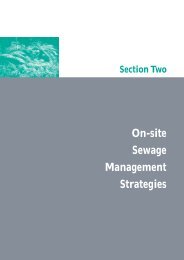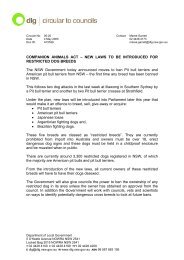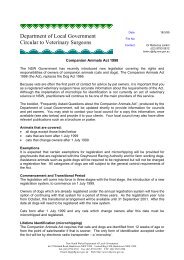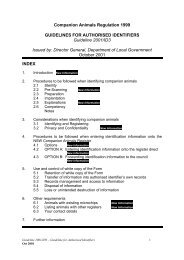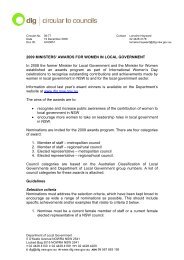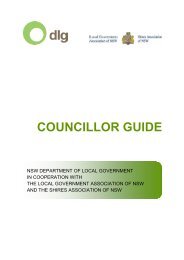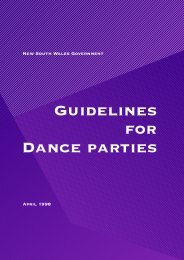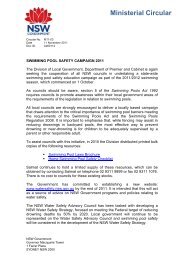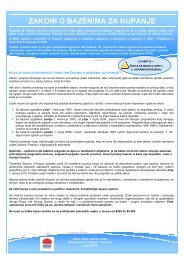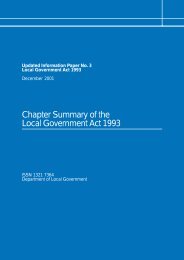Practice Note No. 15 - Water Safety - Division of Local Government ...
Practice Note No. 15 - Water Safety - Division of Local Government ...
Practice Note No. 15 - Water Safety - Division of Local Government ...
Create successful ePaper yourself
Turn your PDF publications into a flip-book with our unique Google optimized e-Paper software.
PRACTICE NOTE NO.<strong>15</strong>December 1998<strong>Water</strong> <strong>Safety</strong>ISSN 1320-6788Department <strong>of</strong> <strong>Local</strong> <strong>Government</strong>
CONTENTSPage1 Introduction 12 What is the legislative and policy basis<strong>of</strong> councils’ water safety function? 23 What are a council’s water safety functions? 33.1 Life saving activities 33.2 Regulatory activities 44 A risk management approach to water safety 55 Training <strong>of</strong> water safety personnel 65.1 Public swimming pools 75.2 Beaches 96 Number <strong>of</strong> trained water safety personnel 107 Equipment and facilities 108 <strong>Water</strong> safety signs 129 Change rooms 1210 Other safety considerations 1311 Further resources 14Appendix 1 Regulatory activities 17Appendix 2 Change room options 19
1. INTRODUCTIONThis <strong>Practice</strong> <strong><strong>No</strong>te</strong> replaces <strong>Practice</strong> <strong><strong>No</strong>te</strong> <strong>No</strong>.10 – Swimming Pools on Public Land <strong>Water</strong> <strong>Safety</strong> (<strong>No</strong>vember1994) - and <strong>Practice</strong> <strong><strong>No</strong>te</strong> <strong>No</strong>.11 – Beach <strong>Safety</strong> (March 1995). While primarily concerned with swimmingpools on public land and beaches, the <strong>Practice</strong> <strong><strong>No</strong>te</strong> is also relevant for other waterways under councilcontrol that are used by the public, such as estuaries and lakes.Public swimming pools and beaches are amongst the most popular places <strong>of</strong> public recreation in NSW.Many local residents and tourists enjoy the sun, sand, surf and relaxed lifestyle typical <strong>of</strong> beaches in thisState. Public swimming pools provide an important venue for many forms <strong>of</strong> water sports, fitness and otherrecreational activities, and are enjoyed by significant numbers within the community throughout the yearand particularly in summer.While provision <strong>of</strong> beaches and public swimming pools is a worthwhile and popular undertaking, councilshave a responsibility to ensure that adequate safeguards are in place to minimise the risk <strong>of</strong> injury and deaththat can be associated with the water. <strong>Local</strong> councils should already be familiar with this activity as onedeserving considerable attention from a risk management perspective.The <strong>Local</strong> <strong>Government</strong> Act 1993 does not currently prescribe any minimum requirements for water safety.However, in recognition <strong>of</strong> the priority placed by the NSW <strong>Government</strong> on ensuring that beaches, publicswimming pools and other waterways are safe for all users, the Department <strong>of</strong> <strong>Local</strong> <strong>Government</strong> hasprepared this <strong>Practice</strong> <strong><strong>No</strong>te</strong> to assist councils to carry out their water safety functions.With regard to swimming pools on public land, this <strong>Practice</strong> <strong><strong>No</strong>te</strong> is equally relevant to pools which thecouncil manages from its own resources; and to those which are managed by another person or body undera lease, licence or other arrangement involving the land and/or the facility.With regard to beaches, this <strong>Practice</strong> <strong><strong>No</strong>te</strong> is equally relevant to beaches where the life saving function iscarried out by council employed lifeguards, or by contracted lifeguards, or by a volunteer surf life savingclub, or by a combination <strong>of</strong> these.The <strong>Practice</strong> <strong><strong>No</strong>te</strong> has been prepared in consultation with organisations involved in water safety. Theseorganisations are listed in Section 11 Further Resources. Councils are encouraged to contact theseorganisations for further assistance.<strong>Practice</strong> <strong><strong>No</strong>te</strong> <strong>15</strong>: <strong>Water</strong> <strong>Safety</strong>1
2. WHAT IS THE LEGISLATIVE AND POLICY BASIS OF COUNCILS’ WATERSAFETY FUNCTION?Under the <strong>Local</strong> <strong>Government</strong> Act 1993 local councils have the power to:Øprovide facilities appropriate to the current and future needs <strong>of</strong> the local community and the widerpublic (section 24)Ømanage public land (Part 2, Chapter 6). Public land is defined as land vested in or under the control <strong>of</strong>the council (with certain exclusions)Ø control various activities (Part 2, Chapter 16)The <strong>Practice</strong> <strong><strong>No</strong>te</strong> has been prepared in the context <strong>of</strong> the NSW <strong>Government</strong>’s NSW Coastal Policy (1997)and the Sydney Regional Coastal Management Strategy (1998).The NSW Coastal Policy aims to guide management, planning and conservation <strong>of</strong> the NSW coastal zone.It recognises the important role local councils play in this area. One <strong>of</strong> the Policy goals which is especiallyrelevant to water safety is to provide for appropriate public access and use. This includes the followingobjectives:To increase public access to foreshores when feasible and environmentally sustainable options areavailable.To ensure risks to human safety from the use <strong>of</strong> coastal resources is minimised.<strong>Practice</strong> <strong><strong>No</strong>te</strong> <strong>15</strong>: <strong>Water</strong> <strong>Safety</strong>The Sydney Regional Coastal Management Strategy supplements the NSW Coastal Policy by aiming toguide coastal planning, management and conservation activities in the coastal zone between Pittwater andSutherland local government areas. One <strong>of</strong> the Strategy’s guiding principles which is particularly relevantto water safety is:Controlled public access to the coast, including beach, foreshore and marine areas, should be maintainedfor recreation, tourism and other public activities. The extent, location and type <strong>of</strong> access may need tobe controlled to mitigate adverse effects <strong>of</strong> this access, to resolve incompatible uses, to conserve andmaintain ecological integrity, or in the interest <strong>of</strong> public safety.This <strong>Practice</strong> <strong><strong>No</strong>te</strong> should also be read in conjunction with the following Department <strong>of</strong> <strong>Local</strong> <strong>Government</strong>guidelines:Ø Competitive Tendering Guidelines, January 19972
Ø Pricing and Costing for Council Businesses. A Guide to Competitive Neutrality, July 1997ØEnvironmental Guidelines. State <strong>of</strong> the Environment Reporting by <strong>Local</strong> <strong>Government</strong>. PromotingEcologically Sustainable Development, April 1998ØSocial/Community Planning and Reporting Guidelines and Social/Community Planning and ReportingManual, May 19983. WHAT ARE A COUNCIL’S WATER SAFETY FUNCTIONS?Councils have two main water safety functions:ØØthe performance <strong>of</strong> life saving activitiesthe performance <strong>of</strong> regulatory activities3.1 Life saving activitiesUnder the <strong>Local</strong> <strong>Government</strong> Act 1993, the council can delegate the life saving function. This means thatthe life saving function can be performed by:Øcouncil employees. While currently being reviewed, the Industrial Relations Act 1996 deems swimmingpool managers and supervisors engaged under contract or lease to be employees. This includesindividuals, husband and wife teams who have formed partnerships, and companies contracted tocouncils to manage or supervise the pool who employ staff to undertake a variety <strong>of</strong> tasksØ any other person or body, other than an employee <strong>of</strong> the council, such as:- a volunteer surf life saving club, or- an organisation providing contracted life saving servicesCouncils will need to determine which mechanisms are the most appropriate to adequately carry out the lifesaving function in their local area. This will involve a decision as to whether the function will be carried outby a council employee, contractor, volunteer, or a combination <strong>of</strong> these. Further information on contractingout services is contained in the Department’s publications Competitive Tendering Guidelines (January 1997)and Pricing and Costing for Council Businesses. A Guide to Competitive Neutrality (July 1997).<strong>Practice</strong> <strong><strong>No</strong>te</strong> <strong>15</strong>: <strong>Water</strong> <strong>Safety</strong>3
3.2 Regulatory activitiesThe power <strong>of</strong> a council to regulate activities at beaches, public swimming pools and other waterways underits control derives from various sections <strong>of</strong> the <strong>Local</strong> <strong>Government</strong> Act 1993. Functions that may be exercisedby a council under this power are those that:ØØinvolve the provision <strong>of</strong> a service under section 24 and are therefore able to be delegated. This includes:- the provision <strong>of</strong> rescue services- the placement <strong>of</strong> any signs, provided council has approved the use <strong>of</strong> these signs. This includesregulatory signs such as swimming prohibited signs, and information signs such as the red andyellow flags and surfcraft permitted sign- general patrolling- educational activitiesare <strong>of</strong> a regulatory nature and are therefore not able to be delegated, except in the specific case <strong>of</strong> thepower to confiscate water-based recreational equipment. This includes:- issuing penalty notices. Penalty notices cannot be issued to children and young people who wereunder the age <strong>of</strong> 10 years at the time the <strong>of</strong>fence was committed (section 53(2) <strong>of</strong> the Fines Act 1996)- taking legal proceedings with regard to breaches <strong>of</strong> signs erected under sections 632 and 633 <strong>of</strong> the<strong>Local</strong> <strong>Government</strong> Act 1993. Legal proceedings cannot be taken against children and young peoplewho were under the age <strong>of</strong> 10 years at the time the <strong>of</strong>fence was committed (section 5 <strong>of</strong> the Children(Criminal Proceedings) Act 1987)- demanding the name and address <strong>of</strong> a person who commits an <strong>of</strong>fence under the Act (section 680 <strong>of</strong>the <strong>Local</strong> <strong>Government</strong> Act 1993)- removing a person committing an <strong>of</strong>fence against the <strong>Local</strong> <strong>Government</strong> Act 1993 on communityland (section 681 <strong>of</strong> the <strong>Local</strong> <strong>Government</strong> Act 1993). It should be noted that community land isspecifically defined by the Act and rarely applies to beaches, for example<strong>Practice</strong> <strong><strong>No</strong>te</strong> <strong>15</strong>: <strong>Water</strong> <strong>Safety</strong>Law enforcement is a core function <strong>of</strong> <strong>Government</strong> and for this reason the delegation by councils <strong>of</strong> thepower to issue penalty notices or to institute legal proceedings to other bodies is limited to council employeesand police <strong>of</strong>ficers. Members <strong>of</strong> volunteer surf life saving clubs and employees <strong>of</strong> organisations providingcontracted life saving services may still provide evidence to authorised council <strong>of</strong>ficers or police in theircapacity as witnesses to an alleged <strong>of</strong>fence.Special provisions in the <strong>Local</strong> <strong>Government</strong> Act allow councils to delegate the power to confiscate waterbasedrecreational equipment to a member <strong>of</strong> a volunteer surf life saving club and/or an employee <strong>of</strong> anorganisation providing contracted life saving services.Further information about the powers <strong>of</strong> council to regulate activities is contained in Appendix 1.Councils should consider the implications <strong>of</strong> the Security Industry Act 1997 in carrying out regulatory activitiesin relation to beaches, public swimming pools and other waterways under their control. These implications areoutlined in the <strong>Local</strong> <strong>Government</strong> and Shires Associations Weekly Circular 39/98 <strong>of</strong> 2 October 1998.4
4. A RISK MANAGEMENT APPROACH TO WATER SAFETYCouncils are encouraged to adopt a risk management approach to water safety, or some other approachwhich is systematic and comprehensive in identifying water safety risks and developing strategies to addressthese risks. Many councils have adopted a risk management approach based on Australian Standard AS/NZ4360 – 1996 Risk Management. This publication is available from Standards Australia (see Section 11Further Resources for contact details).A risk management approach, or any other approach concerned with water safety, will need to consider anumber <strong>of</strong> factors.In regard to public swimming pools, factors that should be considered include:ØØØØØnumber <strong>of</strong> patronscharacteristics <strong>of</strong> patrons, for example, age and swimming abilitydesign <strong>of</strong> the facility and the impact this has on visual surveillance <strong>of</strong> patronssize and shape <strong>of</strong> poolsnature <strong>of</strong> activities available such as diving towers and water slides, aquarobics, and learn-to-swimclassesIn regard to beaches and other waterways, factors that should be considered include:Ø number <strong>of</strong> usersØ characteristics <strong>of</strong> users, for example, age and swimming abilityØ location, for example, its proximity to emergency services such as ambulanceØ geographic layout and the impact this has on visual surveillance <strong>of</strong> usersØ number and size <strong>of</strong> patrolled and unpatrolled areasØ characteristics <strong>of</strong> beaches, such as rips and other surf conditions, and the location <strong>of</strong> rocks and otherhazards. Councils might find the publication Beaches <strong>of</strong> the New South Wales Coast. A guide to theirnature, characteristics, surf and safety useful as it describes such characteristics and allocates a safetyrating for each NSW beach. The publication is available from Surf Life Saving NSW (see Section 11Further Resources for contact details)Some councils use computerised risk management programs, for example:Ø Wollongong City Council has developed a comprehensive system called Corporate Asset ProtectionSystem (CAPS) which is also used to assist the council in carrying out its water safety functions (seeSection 11 Further Resources for contact details for Wollongong Council for further information)<strong>Practice</strong> <strong><strong>No</strong>te</strong> <strong>15</strong>: <strong>Water</strong> <strong>Safety</strong>5
Øthe Australian Beach <strong>Safety</strong> and Management Program. This program, established in 1990, is a jointSurf Life Saving Australia and University <strong>of</strong> Sydney initiative based at Surf Life Saving NSW. Thepublication mentioned above, Beaches <strong>of</strong> the New South Wales Coast, was produced as part <strong>of</strong> thisprogram. To complement the publication, a computer disk to enable local councils determine the level<strong>of</strong> staffing and the equipment appropriate for beaches is also available from Surf Life Saving NSW(see Section 11 Further Resources for contact details). The disk is available free <strong>of</strong> charge with thepurchase <strong>of</strong> the Beaches <strong>of</strong> the New South Wales Coast publicationCouncils may find The Royal Life Saving Society Australia publication, <strong>Safety</strong> in Swimming Pools –Guidelines for Safe Pool Operation NSW useful in incorporating public swimming pools into their riskmanagement program (see Section 11 Further Resources for contact details).The implementation <strong>of</strong> any risk management or other program concerned with water safety, should be monitoredto ensure that the program remains appropriate and effective. Monitoring should be regular and ongoing, and theprogram revised, if necessary. The council remains responsible for the effective implementation <strong>of</strong> any riskmanagement program regardless <strong>of</strong> whom council has delegated the life saving function to.5. TRAINING OF WATER SAFETY PERSONNELRegardless <strong>of</strong> whom the life saving function is delegated to, it is the council’s responsibility to ensure thatthose carrying out the function have the life saving skills necessary to adequately address the risks associatedwith the characteristics <strong>of</strong> the public swimming pools, beaches, and other waterways under council’s control(see Section 4 A Risk Management Approach to <strong>Water</strong> <strong>Safety</strong>).<strong>Practice</strong> <strong><strong>No</strong>te</strong> <strong>15</strong>: <strong>Water</strong> <strong>Safety</strong>The <strong>Practice</strong> <strong><strong>No</strong>te</strong> sets out recommended minimum standards. This does not preclude councils from adoptinghigher standards if these are considered appropriate. Indeed, because <strong>of</strong> the characteristics <strong>of</strong> their publicswimming pools and/or beaches, many councils have adopted higher standards. For further informationabout the recommended minimum and higher standards <strong>of</strong> water safety training, it is suggested that councilscontact the Aquatic and Recreation Institute or The Royal Life Saving Society Australia in the case <strong>of</strong>swimming pools; and the Australian Pr<strong>of</strong>essional Ocean Lifeguard Association, Surf Life Saving NSW orThe Royal Life Saving Society Australia in relation to beaches (see Section 11 Further Resources for contactdetails). Contact details for other organisations mentioned in sections 5.1 and 5.2 below are also providedin Section 11 Further Resources.Councils should be committed to the ongoing training <strong>of</strong> water safety personnel. Training certificates onlyremain current for a short period <strong>of</strong> time as skills need to be practised continually. Consequently, councils shouldensure that personnel are provided with frequent opportunities, for example monthly, to practise their skills.Separate standards are set out below for public swimming pools and beaches because staff require somewhatdifferent qualifications.6
5.1 Public swimming poolsA number <strong>of</strong> different categories <strong>of</strong> water safety personnel carry out water safety activities at public swimmingpools. Separate standards are set out below for pool attendants/lifeguards, supervisory personnel, pool/centre managers, and learn-to-swim teachers.5.1.1 Pool attendant/lifeguardA council should consider as a minimum standard <strong>of</strong> training for pool attendants/lifeguards the following:Øfor facilities with one or two separate bodies <strong>of</strong> water (e.g. a 50m pool and a toddlers pool) – at leastone member <strong>of</strong> staff on duty has a current bronze medallion from The Royal Life Saving SocietyAustralia or an equivalent award award recognised by the Aquatic and Recreation Institute.Øfor facilities with three or more separate bodies <strong>of</strong> water (e.g. a 50m pool, a toddlers pool and a divingpool):- at least one member <strong>of</strong> staff on duty has a current Pool Lifeguard Certificate from The Royal LifeSaving Society Australia or an equivalent award recognised by the Aquatic and Recreation Institute.The certificate/award should specify the type <strong>of</strong> equipment the holder has been trained on and thedepth <strong>of</strong> the pool where the holder was examined.- all other pool attendants/lifeguards have a current bronze medallion from The Royal Life SavingSociety Australia or an equivalent award award recognised by the Aquatic and Recreation Institute.Ø for all facilities, a current first aid certificate from:- Australian Red Cross- St John Ambulance Australia- The Royal Life Saving Society Australiaor an equivalent award from a training provider approved by WorkCover NSW.Ø for all facilities, a current advanced resuscitation certificate, which includes the use <strong>of</strong> oxygen from:- Australian Red Cross- National Heart Foundation- St John Ambulance Australia- Surf Life Saving NSW- The Royal Life Saving Society AustraliaThe certificate/award should specify the type <strong>of</strong> equipment the holder has been trained on. Councils shouldensure that water safety personnel are trained to use the particular oxygen equipment provided.<strong>Practice</strong> <strong><strong>No</strong>te</strong> <strong>15</strong>: <strong>Water</strong> <strong>Safety</strong>7
5.1.2 Supervisory personnelA council should consider as a minimum standard <strong>of</strong> training for senior pool attendants, shift supervisors andother supervisory personnel a current Pool Lifeguard Certificate from The Royal Life Saving Society <strong>of</strong> Australiaor an equivalent award recognised by the Aquatic and Recreation Institute. The certificate/award should specifythe type <strong>of</strong> equipment the holder has been trained on and the depth <strong>of</strong> the pool where the holder was examined.This is in addition to the minimum standards for Pool Attendant/Lifeguard (see 5.1.1).5.1.3 Pool/centre managerThe position <strong>of</strong> pool/centre manager requires expertise in a range <strong>of</strong> areas such as:ØØØØØØØmaintenance <strong>of</strong> water quality, including testing, chemical treatment, disease controlvision <strong>of</strong> emergency life saving servicesplant operation and maintenancemanagement, including business operation, human resource management and public relationsawareness <strong>of</strong> the Occupational Health and <strong>Safety</strong> Actrisk managementsafe chemical handlingThe council should consider as a minimum standard <strong>of</strong> training for pool/centre managers the SwimmingPool Operations Certificate II and Aquatic Facility Manager Certificate IV or an equivalent award recognisedby the Aquatic and Recreation Institute.5.1.4 Learn-to-swim teaching staff<strong>Practice</strong> <strong><strong>No</strong>te</strong> <strong>15</strong>: <strong>Water</strong> <strong>Safety</strong>A critical factor affecting water safety is the swimming and water safety skills <strong>of</strong> patrons. It is important,then, that personnel teaching learn-to-swim programs are appropriately trained. A council should consideras a minimum standard <strong>of</strong> training for learn-to-swim teaching staff the following qualifications:Ø general - the AUSTSWIM Teacher <strong>of</strong> Swimming and <strong>Water</strong> <strong>Safety</strong> certificateØ specialist areas:- the AUSTSWIM Teacher <strong>of</strong> Infant Aquatics certificate- the AUSTSWIM Teacher <strong>of</strong> People with Disabilities certificateor an equivalent award recognised by the Aquatic and Recreation Institute.8
5.2 BeachesIn determining the appropriate standard <strong>of</strong> training <strong>of</strong> those who perform the life saving function on beaches,councils will need to take into account the following:Øthe number <strong>of</strong> council employed or contracted lifeguards on duty at any one time. Further informationabout this is provided in Section 6 Number <strong>of</strong> Trained <strong>Water</strong> <strong>Safety</strong> PersonnelØwhether or not a volunteer surf life saving club is on duty. Because <strong>of</strong> their voluntary membership, itcannot be expected that all members <strong>of</strong> a club have the same standards <strong>of</strong> training. However, thecouncil should ensure that the club can provide an appropriate number <strong>of</strong> personnel on duty who havethe minimum standards <strong>of</strong> training set out belowA council should consider as a minimum standard <strong>of</strong> training the following:Ø where the life saving function is carried out by a council employed lifeguard or contracted lifeguard -a current Gold Medallion (Advanced Life Saving) from Surf Life Saving NSW or equivalent awardØwhere the life saving function is carried out by a volunteer life saving club - a current Surf BronzeMedallion from Surf Life Saving NSWØregardless <strong>of</strong> who carries out the life saving function, a current first aid certificate from:- Australian Red Cross- St John Ambulance Australia- Surf Life Saving NSW- The Royal Life Saving Society Australiaor an equivalent award from a training provider approved by WorkCover NSW.Ø regardless <strong>of</strong> who carries out the life saving function, a current advanced resuscitation certificate,which includes the use <strong>of</strong> oxygen from:- Australian Red Cross- National Heart Foundation- St John Ambulance Australia- Surf Life Saving NSW- The Royal Life Saving Society AustraliaThe certificate/award specify the type <strong>of</strong> equipment the holder has been trained on. Councils should ensurethat water safety personnel are trained to use the particular oxygen equipment provided.<strong>Practice</strong> <strong><strong>No</strong>te</strong> <strong>15</strong>: <strong>Water</strong> <strong>Safety</strong>9
6. NUMBER OF TRAINED WATER SAFETY PERSONNELThe number <strong>of</strong> trained personnel that need to be on duty to adequately deal with emergencies will depend onthe circumstances <strong>of</strong> each swimming pool, beach and other waterway under council’s control. These includethose factors which need to be considered in the development <strong>of</strong> a risk management strategy or any otherstrategy concerned with water safety (see Section 4 A Risk Management Approach).The limitations <strong>of</strong> one person being on duty should be carefully considered. For example, the area may notbe under visual surveillance during a rescue or when the person is carrying out first aid. The AustralianResuscitation Council recommends two trained personnel as the minimum number necessary to provideeffective bag-valve-mask oxygen resuscitation.Where only one person is on duty, the council should ensure that emergency support is available andarrangements are in place so that it can be immediately summoned. The support might consist <strong>of</strong> communitymembers who have appropriate training, or an appropriate emergency service such as ambulance.Having considered all relevant factors, if a council decides not to staff a facility or to staff it only at certaintimes, it should consider implementing other safety precautions. In the case <strong>of</strong> a public swimming pool, thismight include the following:Øproper fencingØa warning notice including resuscitation instructions as prescribed under the Swimming Pools Act1992 prominently displayed in the vicinity <strong>of</strong> the pool. These signs are available from variousorganisations such as The Royal Life Saving Society Australia (see Section 11 Further Resources forcontact details)<strong>Practice</strong> <strong><strong>No</strong>te</strong> <strong>15</strong>: <strong>Water</strong> <strong>Safety</strong>Ø procedures in place to deal with emergencies, including a quick and direct means <strong>of</strong> communication toemergency services7. EQUIPMENT AND FACILITIES<strong>Water</strong> safety personnel need to have equipment and facilities which enable them to respond effectively toemergency situations. The type <strong>of</strong> equipment and facilities will depend on the circumstances <strong>of</strong> eachswimming pool, beach and waterway under council’s control.As a minimum, a council should consider providing the following equipment and facilities:Ø rescue aids. In the case <strong>of</strong> public swimming pools, these are a reaching pole, a throwing aid such as arope or flotation device, a spine board with straps, and a spinal collar. In the case <strong>of</strong> beaches, these area rescue board or another kind <strong>of</strong> flotation device such as a rescue tube10
Øa first aid kit and a first aid room, or other suitable area where emergency treatment can be performed.Councils are encouraged to obtain a copy <strong>of</strong> the Active Australia brochure, What Do You Need for aFirst Aid Kit and Treatment Room?, from the Australian Sports Commission (see Section 11 FurtherResources for contact details)ØOxygen Resuscitation Equipment sufficient to enable bag-valve-mask oxygen resuscitation to beundertakenØwater safety signs. The <strong>Local</strong> <strong>Government</strong> (General) Regulation 1993 requires that signs comply withAustralian Standard 2416 – 1985 Design and Application <strong>of</strong> <strong>Water</strong> <strong>Safety</strong> Signs. This publication isavailable from Standards Australia (see Section 11 Further Resources for contact details). Section 8Signs provides further information about water safety signsØa device to warn the public about potential danger. This can include a whistleØa quick and direct means <strong>of</strong> communication between water safety personnel and emergency services.This can include a telephoneAny equipment or facilities should:Øcomply with the requirements <strong>of</strong> the Occupational Health and <strong>Safety</strong> ActØcomply with any relevant standards produced by Standards AustraliaØbe readily accessible to trained water safety personnelØ be <strong>of</strong> a design that water safety personnel have been trained to useØ be stored, maintained and operated in accordance with any manufacturer’s instructionsFor further information about water safety equipment and facilities, it is suggested that councils contact theAquatic and Recreation Institute or The Royal Life Saving Society Australia in the case <strong>of</strong> swimming pools;and the Australian Pr<strong>of</strong>essional Ocean Lifeguard Association, Surf Life Saving NSW or The Royal LifeSaving Society Australia in relation to beaches (see Section 11 Further Resources for contact details).<strong>Practice</strong> <strong><strong>No</strong>te</strong> <strong>15</strong>: <strong>Water</strong> <strong>Safety</strong>11
8. WATER SAFETY SIGNSIn response to a number <strong>of</strong> tragic drownings during the summer <strong>of</strong> 1997-98, the Premier established aMinisterial Taskforce on <strong>Water</strong> <strong>Safety</strong> and a supporting <strong>Water</strong> <strong>Safety</strong> Taskforce Sub-committee to encouragesafer swimming on beaches and in other waterways. A <strong>Water</strong> <strong>Safety</strong> Signage Working Group was alsoestablished. The Working Group is chaired by the Department <strong>of</strong> <strong>Local</strong> <strong>Government</strong>, and includesrepresentatives from the <strong>Local</strong> <strong>Government</strong> and Shires Associations, Surf Life Saving NSW, the AustralianPr<strong>of</strong>essional Ocean Lifeguard Association, The Royal Life Saving Society Australia, the <strong>Water</strong>waysAuthority, and the National Parks and Wildlife Service.All local councils were surveyed in March 1998 about certain aspects <strong>of</strong> their water safety signage. Asummary <strong>of</strong> findings from the survey was attached to Council Circular 98/40 dated 20 May 1998. Adetailed report on the findings is available at the Department’s web site on the internet. The survey foundthat many councils were not complying with the Australian Standard on water safety signs. As a result, the<strong>Water</strong> <strong>Safety</strong> Signage Working Group undertook a review <strong>of</strong> existing standards and policies regardingwater safety signage. The purpose <strong>of</strong> the review is to investigate the feasibility <strong>of</strong> developing a consistentapproach to water safety signage in NSW. The review is to be completed in 1999.The Working Group has provided input into a best practice manual for local councils concerning signage.The manual, Information Signs as Remote Supervision, has been developed by the Jardine Group for StatewideMutual, which is the insurer for most local councils in NSW. It outlines a risk management process forcouncils to use to select the most appropriate type, number and location <strong>of</strong> information signs for theirbeaches, public swimming pools, other waterways and public reserves. A CDROM version <strong>of</strong> the manualhas been distributed to those councils insured with Statewide. A copy <strong>of</strong> the manual is also available on theinternet at www.statewide.nsw.gov.au. Those councils not insured through Statewide will need to contactthe Jardine Group to obtain access to the manual (see Section 11 Further Resources for contact details).<strong>Practice</strong> <strong><strong>No</strong>te</strong> <strong>15</strong>: <strong>Water</strong> <strong>Safety</strong>The manual also provides information about relevant legal decisions regarding public liability. Councilsare encouraged to use the manual. Statewide Mutual considers that by adopting the approach outlined in themanual, a council will be taking reasonable measures under its duty <strong>of</strong> care to warn patrons <strong>of</strong> hazardswithin their reserves, beaches, swimming pools and other waterways under its control.Councils are also encouraged to use The Royal Life Saving Society Australia publication, <strong>Safety</strong> in SwimmingPools – Guidelines for Safe Pool Operation in relation to water safety signs at public swimming pools (seeSection 11 Further Resources for contact details).9. CHANGE ROOMSThis section <strong>of</strong> the <strong>Practice</strong> <strong><strong>No</strong>te</strong> has been prepared in the context <strong>of</strong> public swimming pool change rooms.However, councils should consider it in relation to other change rooms they provide, for example at beaches andsporting ovals, particularly in light <strong>of</strong> the findings from the Wood Royal Commission concerning paedophilia.12
Concern has been expressed by members <strong>of</strong> the public about single sex change rooms being used by olderchildren <strong>of</strong> the opposite sex, accompanied by a parent, at public swimming pools. In particular, concern has beenexpressed about older boys and male teenagers, accompanied by their mother, using the women’s change roomwhen girls and young women are present. The reason parents <strong>of</strong>ten want to accompany older children while theyare getting changed is to protect them from inappropriate behaviour by other users <strong>of</strong> the change room.Public swimming pools differ in the change room facilities they provide. The different change roomarrangements are described in Appendix 2, along with options in relation to addressing the use <strong>of</strong> single sexchange rooms by children <strong>of</strong> the opposite sex.10. OTHER SAFETY CONSIDERATIONSOther aspects <strong>of</strong> water safety councils should consider include:Øattention to the design <strong>of</strong> facilities, the use <strong>of</strong> appropriate surface materials and regular maintenance.Councils are encouraged to use The Royal Life Saving Society Australia publication, <strong>Safety</strong> in SwimmingPools – Guidelines for Safe Pool Operation (see Section 11 Further Resources for contact details).Councils are also encouraged to contact the NSW Department <strong>of</strong> Sport and Recreation and/or theAquatic and Recreation Institute for information and advice in relation to the design <strong>of</strong> safe poolfacilities (see Section 11 Further Resources for contact details)Øprovision <strong>of</strong> shade protection. Councils are encouraged to use the NSW Cancer Council publication,Under cover. Guidelines for shade planning and design (see Section 11 Further Resources for contactdetails). As well as providing general information about planning, designing and constructing shadeprotection, the guidelines provide recommendations and considerations for shade provision at a range<strong>of</strong> specific sites including public swimming pools and beachesØØa clear and practised procedure for dealing with emergencies, including emergency signals andevacuation plans. For further information about this, it is suggested that councils contact the Aquaticand Recreation Institute or The Royal Life Saving Society Australia in the case <strong>of</strong> swimming pools;and the Australian Pr<strong>of</strong>essional Ocean Lifeguard Association, The Royal Life Saving Society Australiaor Surf Life Saving NSW in relation to beaches (see Section 11 Further Resources for contact details)effective strategies for ensuring that young children are adequately supervised at public swimmingpools. Advice provided by the Anti-discrimination Board indicates that preventing entry to childrennot accompanied by an adult constitutes discrimination in access to facilities based on age under theAnti-discrimination Act. While the Act provides for exemptions, a strong case <strong>of</strong> special need wouldhave to be established. Councils should consider implementing alternative strategies such as an entryfee structure that encourages family groups and that reflects the cost to council <strong>of</strong> more diligentsupervision <strong>of</strong> young children, and taking strong action in respect <strong>of</strong> any person who fails to complywith standards for safe behaviour at the pool.<strong>Practice</strong> <strong><strong>No</strong>te</strong> <strong>15</strong>: <strong>Water</strong> <strong>Safety</strong>13
11. FURTHER RESOURCESAquatic and Recreation Institute18 Box RoadTAREN POINT NSW 2229Phone: (02) 9542 7255Fax: (02) 9542 7563Email: soldout_events@bigpond.com.auAustralian Pr<strong>of</strong>essional Ocean Lifeguard Association (APOLA)PO Box 3512WAMBERAL NSW 2260Phone: (02) 4385 5267Fax: (02) 4385 5267APOLA can provide information about the provision <strong>of</strong> contracted lifeguarding services between councils.Australian Red Cross (NSW)<strong>15</strong>9 Clarence StreetSYDNEY NSW 2000Phone: (02) 9229 4111Fax: (02) 9229 4165Australian Sports CommissionParticipation <strong>Division</strong>PO Box 176BELCONNEN ACT 2616Phone: (02) 6214 19<strong>15</strong>Fax: (02) 6214 1224<strong>Practice</strong> <strong><strong>No</strong>te</strong> <strong>15</strong>: <strong>Water</strong> <strong>Safety</strong>AUSTSWIM (NSW) Inc.PO Box 2263NORTH PARRAMATTA NSW 1750Phone: (02) 9890 5099Fax: (02) 9890 5199Email: austswim@bigpond.com.auWeb site: www.austswim.nsw.com.auJardine GroupGPO Box 7003SYDNEY NSW 2001Phone: (02) 9320 2770Fax: (02) 9320 279914
National Heart Foundation (NSW)Level 4407 Elizabeth StreetSURRY HILLS NSW 2010Phone: (02) 9219 2444Fax: (02) 9219 2424NSW Cancer CouncilPO Box 572KINGS CROSS NSW 1340Phone: (02) 9334 1900Fax: (02) 9326 9328NSW Department <strong>of</strong> Sport and RecreationManager Facility Design and DevelopmentPO Box 422NORTH SYDNEY NSW 2059Phone: (02) 9923 4216Fax: (02) 9923 <strong>15</strong>64The Royal Life Saving Society Australia (NSW)PO Box 753GLADESVILLE NSW 1675Phone: (02) 9879 4699Fax: (02) 9879 4644Email: rlssnsw@msn.com.auStandards AustraliaPO Box 1055STRATHFIELD NSW 2135Phone: 1300 654646Fax: (02) 9746 3333St John Ambulance Australia (NSW)St John House6 Hunt StreetSURRY HILLS NSW 2010Phone: (02) 9212 1088Fax: (02) 9281 6923<strong>Practice</strong> <strong><strong>No</strong>te</strong> <strong>15</strong>: <strong>Water</strong> <strong>Safety</strong><strong>15</strong>
Surf Life Saving NSWPO Box 430NARRABEEN NSW 2101Phone: (02) 9984 7188Fax: (02) 9984 7199Email: experts@surflifesaving.com.auSurf Life Saving NSW provide a contract lifeguard service through:Surf Life Saving Services Pty LtdLot 1 Dympna RoadCROMER NSW 2099Phone: (02) 9984 7249Fax: (02) 9984 7199Email: lmiller@australianlifeguards.com.auWorkCover NSWGPO Box 5364SYDNEY NSW 2001Phone: (02) 9370 5300Fax: (02) 9370 6107Wollongong City Council – Corporate Asset Protection Scheme (CAPS)Dennis Williams, phone (02) 4227 7045Simon Iliffe, phone (02) 4227 7007<strong>Practice</strong> <strong><strong>No</strong>te</strong> <strong>15</strong>: <strong>Water</strong> <strong>Safety</strong>16
APPENDIX 1REGULATORY ACTIVITIESPower to erect and enforce notices to control activities in a public placeUnder the <strong>Local</strong> <strong>Government</strong> Act 1993, a council may erect notices controlling certain activities in publicplaces, including public beaches and public land near beaches. These activities include:ØØØØØØthe consumption <strong>of</strong> alcohol (s632)controlling animals (s632)the use <strong>of</strong> water-based recreational equipment, including surboards, windsurfers and jet skis (s633)the conduct and costume <strong>of</strong> people on the beach (s633)using the beach for nude bathing (s633)the use <strong>of</strong> skateboards, roller blades and roller skates (s633A)Failure to comply with a notice is an <strong>of</strong>fence, subject to a maximum penalty <strong>of</strong> 5 penalty units (i.e. $550).Councils may delegate the authority to erect water safety signs to members <strong>of</strong> water safety organisations.Any person, including water safety personnel who are not employees <strong>of</strong> the council, may request thatpeople obey any notices erected by the council. However, if any person refuses that request, only anappropriately authorised council employee can enforce compliance. Police help may be sought if the councilemployee is not available.Only authorised council employees, or the police, may take action to prosecute persons who do not complywith a notice <strong>of</strong> the council. However, other water safety personnel may provide evidence in their capacityas witnesses to an alleged <strong>of</strong>fence.Confiscation <strong>of</strong> water-based recreational equipmentConfiscation <strong>of</strong> water-based recreational equipment is a unique situation in that this power may be exercisedby a member <strong>of</strong> a surf life saving organisation who has been appropriately authorised by the council.Under section 681A <strong>of</strong> the <strong>Local</strong> <strong>Government</strong> Act, the power to confiscate water-based recreational equipmentmay be exercised by:ØØØan employee <strong>of</strong> the council authorised by the council in writing to carry out this functiona police <strong>of</strong>ficera member <strong>of</strong> a surf life saving organisation who is authorised by the council in writing to carry out thisfunctionIf water-based recreational equipment is being used in contravention <strong>of</strong> notices erected by the council undersection 633 <strong>of</strong> the Act, an authorised person can give a warning that the misuse must stop. If the misusecontinues the authorised person may confiscate the equipment, but may not use force to do so.<strong>Practice</strong> <strong><strong>No</strong>te</strong> <strong>15</strong>: <strong>Water</strong> <strong>Safety</strong>17
When equipment is confiscated the authorised person must give the person who had possession a receiptshowing the nature <strong>of</strong> the equipment and the time and date it was taken. The receipt could also describedistinguishing features <strong>of</strong> the equipment, for example, colours, design and any existing damage. Theconfiscated equipment must be returned to that person or delivered to a public pound within 24 hours. If theconfiscated equipment is taken to a pound the person from whom it was taken must be notified in writing <strong>of</strong>the address <strong>of</strong> the pound.The Impounding Act 1993 (sections 20 and 23 (2)(b) and (c) excepted) applies to confiscated equipmentthat is delivered to the pound. In summary:Øthe equipment must be released on demand without payment <strong>of</strong> fees or chargesØthe impounding authority must be satisfied that the person who requests the equipment is the owner, isauthorised to claim the equipment, or is otherwise entitled to lawful possession <strong>of</strong> the equipmentØthe person must sign a receipt for the release <strong>of</strong> the equipmentØthe equipment may be sold by public auction or public tender if not released within 28 daysOther <strong>of</strong>fences under the <strong>Local</strong> <strong>Government</strong> ActOther <strong>of</strong>fences under the <strong>Local</strong> <strong>Government</strong> Act 1993 relating to public behaviour in public places, includingbeaches and public swimming pools, include:Øwilfully breaking, throwing or leaving a bottle, glass, syringe or anything likely to endanger or causeinjury to any person in a public place (s630)Ødamaging, defacing or polluting a public bathing place (s631)<strong>Practice</strong> <strong><strong>No</strong>te</strong> <strong>15</strong>: <strong>Water</strong> <strong>Safety</strong>ØØusing loudspeakers or sound amplifying device without prior approval <strong>of</strong> the council (s68; s626). Itshould be noted that section 68 only applies to community landwilfully obstructing water safety personnel, duly authorised by a council, in carrying out their functions(s660)Any person, including water safety personnel who are not employees <strong>of</strong> the council, may request thatpeople comply with these provisions <strong>of</strong> the Act. However, if any person refuses that request, only anappropriately authorised council employee can enforce compliance. Police help may be sought if the councilemployee is not available.Only authorised council employees, or the police, may take action to prosecute persons who do not complywith these provisions. However, other water safety personnel may provide evidence in their capacity aswitnesses to an alleged <strong>of</strong>fence.18
APPENDIX 2CHANGE ROOM OPTIONSSwimming pools with family change roomsSwimming pools are currently being constructed which usually provide either separate change rooms forfamilies or, more commonly, combined change rooms for people with disabilities and families. Thesechange rooms are in addition to single sex change rooms.In most instances these facilities will be adequate so that there will be no need for children to use changerooms for use by the opposite sex. However, there may be times when there is a high level <strong>of</strong> demand forthe family change rooms, particularly where these change rooms are also used by people with disabilities.Consequently, councils should consider developing a policy concerning the following:Øpriority to be given to people with disabilitiesØthe use <strong>of</strong> single sex change rooms by children <strong>of</strong> the opposite sex (see section below on development<strong>of</strong> a council policy)Swimming pools without family change rooms but with separate change rooms for people withdisabilitiesWhere swimming pools do not have family change rooms but do have separate change rooms for peoplewith disabilities, that is, they do not require patrons to move through single sex change rooms to gain accessto them, consideration should be given to making these facilities available for use by families.The provision <strong>of</strong> combined change rooms for people with disabilities and families is consistent with theBuilding Code <strong>of</strong> Australia which provides for toilets and showers for people with disabilities at publicfacilities to also be used by other people.Making change room facilities currently available for people with disabilities available to families maymean that there are occasions when people with disabilities will not be able to use the facilities withouthaving to wait a substantial period <strong>of</strong> time. Consequently, councils should consider developing a policyconcerning the following:Ø priority to be given to people with disabilitiesØ the use <strong>of</strong> single sex change rooms by children <strong>of</strong> the opposite sex (see section below on development<strong>of</strong> a council policy)<strong>Practice</strong> <strong><strong>No</strong>te</strong> <strong>15</strong>: <strong>Water</strong> <strong>Safety</strong>19
Swimming pools with single sex change rooms onlyWhere swimming pools have single sex change rooms only, consideration should be given to the followingoptions:Øconstruction <strong>of</strong> a new change room(s) for use by familiesØmodification <strong>of</strong> existing facilities to provide a change room(s) for use by familiesØallocation <strong>of</strong> a lockable cubicle(s) within single sex change rooms for use by children <strong>of</strong> the oppositesex and their parent. This should be located near the entrance to the change rooms so as to minimiseany adverse impact on other patronsØdevelopment <strong>of</strong> a policy regarding children using change rooms for the opposite sex (see sectionbelow on development <strong>of</strong> a council policy)Development <strong>of</strong> a council policyUnder Ordinance <strong>No</strong>.52 <strong>of</strong> the former <strong>Local</strong> <strong>Government</strong> Act 1919, the maximum age at which childrencould be taken into a change room used by the opposite sex was eight years. This provision does not existunder the current <strong>Local</strong> <strong>Government</strong> Act 1993. Therefore, this is a matter for council discretion.Different policies have developed among councils throughout NSW in relation to this issue. Informationprovided by a sample <strong>of</strong> councils showed that the maximum age permitted to use change rooms for theopposite sex ranged from 4 years, or up to school age, to seven or eight years. The Aquatic and RecreationInstitute recommends that children aged seven years and under be allowed to use change rooms for theopposite sex. While in some cases, this information was displayed on signs, in many cases patrons onlybecome aware <strong>of</strong> the policy after a complaint had been made to pool staff by another patron.<strong>Practice</strong> <strong><strong>No</strong>te</strong> <strong>15</strong>: <strong>Water</strong> <strong>Safety</strong>Councils are therefore encouraged to develop a policy concerning the use <strong>of</strong> change rooms by children <strong>of</strong>the opposite sex. In developing such a policy, an appropriate balance between the right <strong>of</strong> children to besafe and the right <strong>of</strong> swimming pool patrons to privacy when changing needs to be achieved. It is importantthat the policy be developed in consultation with patrons. Particular attention should be given to consultingwith patrons from non-English speaking backgrounds in a culturally appropriate way.The policy might provide for the following:ØØa maximum age for children to use change rooms for the opposite sexallocation <strong>of</strong> a lockable cubicle(s) within single sex change rooms for use by children <strong>of</strong> the oppositesex and their parent20
Øpool staff to be available to accompany children over the maximum age into the appropriate changeroom where another suitable adult, such as a family member <strong>of</strong> the same sex as the child or youngperson, is not available. However, this should not be at the expense <strong>of</strong> maintaining an adequate level<strong>of</strong> supervision <strong>of</strong> the pool itselfØadequate supervision <strong>of</strong> change rooms by staff to ensure that they are being used appropriately and inaccordance with the policyØnotices to be erected informing patrons about the policy. <strong>No</strong>tices should be prominently displayednear the entrance to the change rooms, both inside and outside, and should be in appropriate communitylanguagesØa procedure for dealing with complaints from patrons about children using change rooms for the oppositesex. It is important that patrons feel able to complain and that their complaint is treated seriouslyØtraining <strong>of</strong> staff specifically in relation to implementation <strong>of</strong> the policy. Consideration should also begiven to training staff generally in gender awareness issues so that they understand the reasons forcomplaints concerning children using change rooms for the opposite sex and the need to deal with suchcomplaints in a sensitive manner<strong>Practice</strong> <strong><strong>No</strong>te</strong> <strong>15</strong>: <strong>Water</strong> <strong>Safety</strong>21



